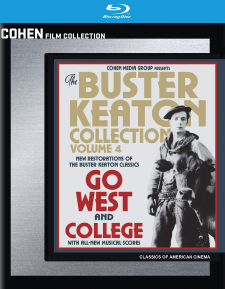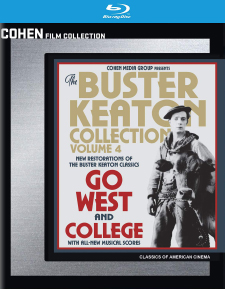Buster Keaton Collection: Volume 4 (Blu-ray Review)

Director
Buster Keaton/James W. HorneRelease Date(s)
1925/1927 (December 8, 2020)Studio(s)
United Artists/MGM (Cohen Film Collection)- Film/Program Grade: See Below
- Video Grade: See Below
- Audio Grade: See Below
- Extras Grade: C
- Overall Grade: B
Review
Buster Keaton is second only to Charlie Chaplin as the greatest comedian of the silent era. Keaton’s physical comedy, deadpan expression, and pork pie hat were his trademarks, and he used them all in creating sympathetic, hardluck characters who persevered through every obstacle. He reached his peak years between 1920 and 1929, when he made features as well as shorts, and he both acted in and directed many of his films. The Buster Keaton Collection: Volume 4 contains two of these feature films.
Go West (1925) relies on lots of sight gags and Keaton’s acrobatic abilities. His character, Friendless, has few prospects in Indiana. Exchanging his meager possessions for a loaf of bread and a salami, he heads out west, hoping for greater opportunities. He winds up on a cattle ranch in Arizona and stays as a hired hand because of his affection for the boss’ daughter (Kathleen Myers). But he’s hopeless at doing chores. He figures that putting a pail under a cow and waiting will yield a bucket of fresh milk. To mount a large horse, he uses a rope ladder. His only friend is Brown Eyes, a cow. He has pried a painful stone from her hoof, and now she follows him everywhere. She even protects him from a charging bull. He later saves her from branding. When he learns she’s bound for the slaughterhouse, he jumps into action.
The cowboys have to move the boss’s herd of cattle onto a train bound for the stockyards of Los Angeles. Friendless sneaks on with them. On the way, the train is hijacked. With the train stopped on the tracks, the film’s big comic set piece begins. Friendless escapes with the whole herd and heads for downtown Los Angeles, where the cattle meander through busy streets, enter stores, and stop traffic, terrorizing people and causing havoc.
The best part of Go West is the relationship between Friendless and Brown Eyes. Charming and funny, it’s the core of the film, with gags built around the affection between man and beast. This may be the first and only film with a cow as the co-star. Oddly expressive, Brown Eyes is a scene-stealer, and contributes to many of the film’s sight gags. By the end, we are won over by her bovine sweetness.
Go West doesn’t quite come up to the high standard of Keaton’s The General or Steamboat Bill, Jr., and the gags aren’t as spectacular. Keaton plays his typical, hapless Everyman, a fish out of water in a new environment, inept and awkward at every turn, struggling through trials and tribulations as he tries his best to fit in. Keaton’s timing and brisk editing move the film along at a nice clip. There’s little extraneous footage, and even a flirtatious moment with the boss’ daughter is glossed over quickly to get on with the comedy.
College (1927) features Keaton as Ronald, a young man graduating from high school who’s more interested in books than athletics. His commencement speech, criticizing the emphasis on athletics in modern education, quickly clears the auditorium. Ronald enrolls in Clayton College to be near his sweetheart, Mary (Anne Cornwall). Mary likes Ronald but has lots of suitors and wants her man to prove himself in conventional ways, by excelling at sports.
To work his way through college, Ronald gets jobs as a drug store soda jerk, making a mess of ice cream sodas and, in a dated sequence, applies for a job as a “colored waiter,” wearing blackface and shuffling lazily from table to table.
Most of the film is devoted to Ronald’s trying his skill (and failing miserably and comically) at baseball, shot put, javelin, hurdles, pole vault, and the high jump. The film climaxes with Ronald as coxswain on the rowing team. The finale finds him rising to the occasion as he incorporates all these athletic skills into exploits that save Mary from the campus bully. The inside joke of College is that Keaton was extremely athletic, as his many daring cinematic stunts proved.
Even at only 66 minutes, College seems overly long, with many of the gags easily telegraphed well before we see them. The big set piece is the rowing race, which features some excellent camera work and crisp editing. Though all of the actors are far too old to be playing high school seniors and college freshmen, the film is a comedy and that may have been part of the joke.
Both films, featuring 1080p resolution, are presented in the aspect ratio of 1.33:1. According to on-screen information before the film, the Keaton Project was launched in 2015 by Cineteca di Bologna and the Cohen Film Collection to restore all films made by Buster Keaton between 1920 and 1928.
For Go West, nine elements were inspected and analyzed, and eight of those deposited in Columbus and at the Library of Congress by the Cohen Film Collection were digitized and compared. The 4-reel camera negative was not complete; some portions were severely affected by chemical decay. It was necessary to integrate the original camera negative with three other elements—a first generation nitrate positive, a second generation safety dupe negative, and a third generation safety dupe positive. The visual quality looks remarkably consistent despite this patch and paste restoration.
For College, a similar procedure was followed in its restoration. A third generation safety dupe positive provided main elements and end titles and inter-titles. A second generation safety dupe negative was used to replace several sections of the dupe positive showing visible chemical decay. There are no major imperfections, though the gradations of grey are not as pronounced as in the Go West restoration and blacks lack a deep, velvety look. With both films shot largely outdoors, natural lighting varies from scene to scene but the variations are slight and not distracting.
The soundtrack for both features is 2.0 DTS-High Definition Master Audio. A new, original score for Go West was composed and performed by the Mont Alto Motion Picture Orchestra. The musical score that accompanies College was compiled by Rodney Sauer and is fairly generic, doing little to enhance the comedy bits.
GO WEST (FILM/VIDEO/AUDIO): A/A-/B
COLLEGE (FILM/VIDEO/AUDIO): B-/B-/B
Bonus materials include the 1923 Hal Roach short Go West, the audio-only Buster Keaton: Screenwriter, and trailers.
Go West (1923) – This Hal Roach short directed by Len Powers features a cast of monkeys in a plot about a father who banishes his no-account son who seeks his fortune out West. Monkeys perform in miniaturized sets dressed like humans, wear wigs, portray train engineers and conductors on scaled-down trains, ride horses, and drive a stagecoach. The short is bizarre, and the simian cast very funny.
Buster Keaton Screenwriter – In an hour-long audio recording, Buster Keaton develops a script idea that he intends to pitch to the producers of TV’s Wagon Train, a popular western series that ran from 1957 to 1965. Keaton’s voice is raspy, the recording isn’t very good, and it’s often difficult to understand what he’s saying.
Trailers – Included are the re-release restoration trailers for Go West and College.
Buster Keaton’s silent films have stood the test of time largely due to their availability. In 1954, Keaton made a deal with Raymond Rohauer to have his films re-released in theaters, and revivals in art houses followed. With the rise of home video, his pictures were once again available to younger generations. Keaton relied on props, his hang-dog expression, and astonishing agility to portray the underdog struggling against a world that seemed to plot against him. But he prevailed time and time again, entertaining audiences in the process.
- Dennis Seuling

